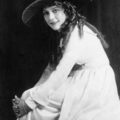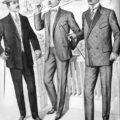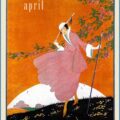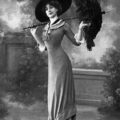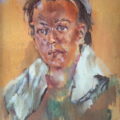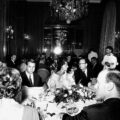1910s womens fashion – The Edwardian period
February 16, 2016At the start of the 1910s, things were going on much as before in the 1900s. Although King Edward VII died in 1910 and King George V took the throne (he was to reign until 1936) the years up until 1914 are still generally known as the Edwardian period. 1910s womens fashion went through quite a few changes from the beginning of the decade to the end.
These first years are looked on as a period of peace and prosperity. Fashion wise, the upper classes still enjoyed the frills and flounces of Lucile’s designs, often in pastel colours, or the contrast of Paul Poiret’s work, which took a dramatic turn for the opposite, in bright colours, heavy silk, and Oriental inspired shapes.
He preferred his designs to be worn with no corset, but certainly didn’t offer women freedom from clothing strictures since the narrow, long “hobble skirt” which he popularised enforced a gait which made women walk with the tiniest of steps. Contemporary cartoons show women splitting their exceedingly tight skirts by doing things like laughing too heartily.
Other cartoons lampoon the top heavy effect of the enormous cartwheel hats that were popular in 1910s womens fashion, dwindling to the tiny calves bound by the hobble skirt. Variations on the hobble included a band of braid sewn around a slightly looser skirt at the knee or ankle, to draw it in and achieve the same effect. It was a strange fashion, literally tying women down.
Womens trouser fashion in the 1910s
At the same time Poiret’s Orientalism extended to a version of baggy Turkish harem pants. These were worn only by very dedicated fashionistas, and generally in a way that looks quite odd to contemporary eyes, mixed and matched with the stern tailoring of the era on top. The stares and jokes these women in trousers received probably didn’t make them feel the garment was particularly freeing either.
Now talking of freedom, I’ve said that this was a period of peace. Not for some women. Suffragists had been working for changes in the law regarding women for over seventy-five years by now, and suddenly, they were tired of doing things carefully and by the book. They were angry.
Votes for women in the 1910s
Parliament had been presented with petitions about votes for women since 1832, and there had been brilliantly argued legal challenges and various appeals to the government ever since. These had been presented through the usual, orthodox channels which it would be unthinkable to ignore if they had been made on any other subject, but the suffragist’s suggestions and demands were simply brushed off.
In 1903 the Women’s Social Political Union (WSPU) was formed by Emmeline Pankhurst. Not everyone agreed with her way of doing things, which was rather militant and not exactly democratic, but these new attention grabbing tactics did get results. Her “army” of women who were looking for universal sufferage quickly got nicknamed the “Suffragettes” by the press, a label that stuck.
The suffragettes slashed paintings in the National Gallery, (Mary Richardson in 1914), chained themselves to railings outside parliament and smashed shop windows. Some took down policemen with Jui-jitsu (Edith Margaret Garrud). In 1913, Emily Wilding Davison died after running out to the King’s horse at the Derby races. She was knocked down by the animal who was running at high speed, and died a few days later in hospital. It has long been thought of a radical suicide stunt, but some now think she was trying to attach suffragist flag or scarf to the horse and didn’t mean to kill herself. In any case, she was aware of the danger and her death attracted a great deal of attention for the cause. 6,000 women attended her funeral.
1910s womens fashion – neat and respectable
And what has this to do with fashion? In Mrs Pankhurst’s view, the best way to get society to listen to you was to present yourself as an attractive, perfectly groomed lady. She strictly enforced modest, middle of the road outfits complete with gloves and hats, and not a hair out of place. In fact, one very intelligent, educated and very vocal woman, Ada Nield Chew, found herself often picked on by the press because although her arguments were sound, her hat apparently was never on straight.
This wan’t new at all. The press had long ridiculed early feminists as harridans and harpies, ugly spinsters who couldn’t get a man and were out to wreck their prettier and gentler married sister’s household harmony by undermining their men’s authority. Mrs Pankhurst’s rules about dress were a strategy to avoid this, and it is said that she put the best dressed and prettiest women to the front of any public suffragist meeting. And as for Mrs Chew, unfortunately physical ridicule is used to undermine making a valid political point goes on to this very day – in January this year (2016) Katie Hopkins criticised an SNP MP based on her hairstyle and appearance, saying “Look at the state of this thing…Presumably her shower is broken?”
1910s womens fashion – the colours of suffragettes
The suffragist colours of white (for purity) green (for hope) and violet (for loyalty to the king) were worn on sashes, hat ribbons, badges and even specially made jewellery. At demonstrations and gatherings, suffragettes were encouraged to wear white dresses, because of the connotations of purity and delicacy.
Many shops showed their support/cashed in on the suffragists, depending on which way you look at it, offering green hats or violet stockings. The cynical viewpoint was that by publicly aligning themselves with the angry women, the businesses might avoid them from smashing their windows and damaging their property.
1910s womens fashion – Selfridges and the department store
The suffragists often met in the new fashionable hangout of the roof cafe in Selfridges. Gordon Selfridge, who opened Selfridges in 1909 was a great supporter of the Suffragists, creating window displays featuring the suffragist colours, and according to legend flying their flag on his roof. When one of his extremely expensive huge plate glass windows was smashed by them anyway, he didn’t press charges or attempt to regain the costs as many businesses did.
Department stores like Selfridges offered women a freedom in an unexpected way. The cliche of the modern woman’s “obsession” with shopping may well come from this era, when shopping was a respectable activity that a woman might do without a chaperone. You could spend a whole day in a department store, which might offer a cafe for lunch, a restaurant for dinner, and even an art gallery amongst the wares. But crucially, they had toilets, so a woman did not need to rush home for that (men peed in alleyways and didn’t need to interrupt their day). Selfridges pioneered the idea that you could come in and browse and need not buy anything but were free to gaze at anything you wish. The store also emphasised that absolutely anyone was welcome, and though it was beautiful there was no need for, say, a working class girl with very little money to feel intimidated.
But in 1914 war was announced and for many, frivolities like shopping and wearing couture melted away. Suffragist activities came to a halt too. Many prominent suffragists turned their attention to encouraging men to sign up to actively fight in the war (as this wasn’t compulsory), and they also began the horrible practice of handing any man they saw on the street who was of fighting age yet not in uniform a white feather. It represented cowardice.
1910s womens fashion – women’s uniform
The war brought changes to most women’s lives and modes of dressing in 1910s womens fashion. Women did not officially fight in this war, but still many found themselves in uniform. It might be a nurse’s uniform, or a factory worker’s. Women filled in the jobs vacated by men away fighting, and some new jobs, such as assembling munitions, were created.
A list of women’s jobs described on a set of patriotic cigarette cards from 1916 runs:
- motor driving
- gamekeeper
- postwoman
- woman porter – railway goods yard or flour mill
- shovelling potatoes for sieving machine
- driving goods – delivery van
- instructing recruits as to use of field kitchen
- piano finishing, tuning and touching
- dentist
- making shells
- ambulance service
- care of horses
- loading up a cart
- harrowing wheat
- preparation of soldier’s dinners
- women in newspaper offices
- train guard
- mechanics – electrical engineering
- window washer
- baker
- roadsweeper
- grocer’s assistant
- pork butcher
- gardening
- woman stoker
- woodworking
- tram conductor
- carriage repairs
- dipping leather
- milk woman
- lift attendant
- red cross nurse
- chemist
- policewoman
- glass manufacture
- woman wagon washer
- electric train cleaner
- steam roller driver
- cleaning a locomotive
- bus conductor
- barrowing coke
- VAD woman
- women transporting refuse
- riddling cinders
- sheet iron worker
- brewery worker
- harvesting
- coal workers
- shipyard worker
Army uniforms
A very few women cross dressed and, disguised as men, joined the army “for a lark” (Dorothy Lawrence) or for revenge, or somehow found themselves swept up in the army of another country. British woman Flora Sandes was a nurse for the Red Cross, and after becoming separated from her compatriots was taken in by the Serbian army, whom she joined as the Serbs allowed female fighters. She rose to become Sergeant Major Sandes, and was found it most peculiar to be back in skirts at the closing of hostilities. Flora Sandes is still very well known in Serbia, and looked on as a hero.
High fashion in war time
Even those upper class women in who didn’t do war work requiring a change of outfit found themselves affected. Some Parisian couture houses were forced to close, and many found it hard to get the luxurious fabrics they were used to. Somehow, it just seemed tacky to be flaunting a lot of wealth and opulence under the circumstances. So although high fashion was still very very expensive, the chicest was made from common sweat shirt fabric with a simple line – witness the birth of Chanel couture.



